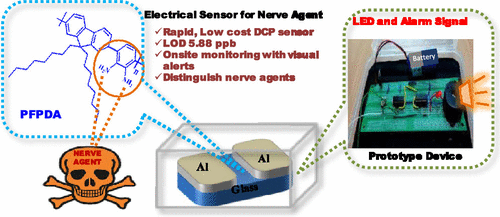Our official English website, www.x-mol.net, welcomes your feedback! (Note: you will need to create a separate account there.)
Conjugated Polymer-Based Electrical Sensor for Ultratrace Vapor-Phase Detection of Nerve Agent Mimics.
ACS Sensors ( IF 8.9 ) Pub Date : 2020-01-09 , DOI: 10.1021/acssensors.9b02031 Nehal Zehra , Anamika Kalita , Akhtar Hussain Malik , Ujjwol Barman , Mohammad Adil Afroz , Parameswar Krishnan Iyer
ACS Sensors ( IF 8.9 ) Pub Date : 2020-01-09 , DOI: 10.1021/acssensors.9b02031 Nehal Zehra , Anamika Kalita , Akhtar Hussain Malik , Ujjwol Barman , Mohammad Adil Afroz , Parameswar Krishnan Iyer

|
Considering the vital need to strengthen the national security emanating from chemical threats, a low-cost, portable ultrasensitive electrical sensor for real-time monitoring of diethylchlorophosphate (DCP) (nerve gas mimic) has been developed. The device consists of a "simple to be fabricated" two-terminal resistor and an electronic combinational circuit for rapid onsite detection of lethal nerve gas vapors with high degree of accuracy in milliseconds. This device is a smart readout electronic model that detects ultratrace DCP vapors by bright visual alerts from light-emitting diode (LED) and loud alarm signal without the need for employing a sophisticated instrument. To obtain high sensitivity and discriminating response, a novel amine-functionalized conjugated polymer (CP) is designed as a sensory channel material for two-terminal sensor. The low-powered poly(3-(9,9-dioctyl-9H-fluoren-2-yl)benzene-1,2-diamine) (PFPDA) fabricated two-terminal electrical sensor is tested at ambient conditions, which shows excellent sensitivity toward nerve gas mimic DCP, with a rapid response in 3 s and a very low limit of detection (LOD) of 5.88 ppb. The amine moiety of PFPDA CP plays a vital role in redox interaction between the semiconductor CP and organophosphates, which ultimately leads to the amplified current signal. The redox interactions occurring among the organophosphate analytes and the amine functional group on the PFPDA backbone provided insights into the mechanism of sensing, which formed the basis of the excellent sensitivity and discriminating ability of this sensor device. The newly designed PFPDA CP-based portable electrical sensor device demonstrates a key contribution in the field of portable electronics for defense safety and environmental monitoring applications.
中文翻译:

基于聚合物的共轭电传感器,用于神经药模拟物的超痕量气相检测。
考虑到加强由化学威胁引起的国家安全的迫切需要,已经开发了一种低成本的便携式超灵敏电传感器,用于实时监测二乙基氯磷酸酯(DCP)(神经毒气模拟物)。该设备由一个“易于制造”的两端电阻器和一个电子组合电路组成,可在几毫秒内以高精确度快速现场检测致命的神经气体蒸气。该设备是一种智能读数电子模型,无需使用复杂的仪器,即可通过发光二极管(LED)发出的明亮视觉警报和响亮的警报信号来检测超痕量DCP蒸气。为了获得高灵敏度并区分响应,一种新型的胺官能化共轭聚合物(CP)被设计为用于两末端传感器的感觉通道材料。在环境条件下测试了低功率聚(3-(9,9-二辛基-9H-芴-2-基)苯-1,2-二胺)(PFPDA)制成的两端电传感器,该传感器显示了出色的灵敏度对神经气体模仿DCP的反应,在3 s内有快速反应,并且检测限(LOD)仅为5.88 ppb。PFPDA CP的胺部分在半导体CP和有机磷酸酯之间的氧化还原相互作用中起着至关重要的作用,最终导致放大的电流信号。PFPDA主链上的有机磷酸盐分析物和胺官能团之间发生的氧化还原相互作用提供了对传感机制的见解,这构成了该传感器装置出色的灵敏度和辨别能力的基础。新设计的基于PFPDA CP的便携式电子传感器设备展示了在便携式电子领域中为国防安全和环境监测应用做出的重要贡献。
更新日期:2020-01-10
中文翻译:

基于聚合物的共轭电传感器,用于神经药模拟物的超痕量气相检测。
考虑到加强由化学威胁引起的国家安全的迫切需要,已经开发了一种低成本的便携式超灵敏电传感器,用于实时监测二乙基氯磷酸酯(DCP)(神经毒气模拟物)。该设备由一个“易于制造”的两端电阻器和一个电子组合电路组成,可在几毫秒内以高精确度快速现场检测致命的神经气体蒸气。该设备是一种智能读数电子模型,无需使用复杂的仪器,即可通过发光二极管(LED)发出的明亮视觉警报和响亮的警报信号来检测超痕量DCP蒸气。为了获得高灵敏度并区分响应,一种新型的胺官能化共轭聚合物(CP)被设计为用于两末端传感器的感觉通道材料。在环境条件下测试了低功率聚(3-(9,9-二辛基-9H-芴-2-基)苯-1,2-二胺)(PFPDA)制成的两端电传感器,该传感器显示了出色的灵敏度对神经气体模仿DCP的反应,在3 s内有快速反应,并且检测限(LOD)仅为5.88 ppb。PFPDA CP的胺部分在半导体CP和有机磷酸酯之间的氧化还原相互作用中起着至关重要的作用,最终导致放大的电流信号。PFPDA主链上的有机磷酸盐分析物和胺官能团之间发生的氧化还原相互作用提供了对传感机制的见解,这构成了该传感器装置出色的灵敏度和辨别能力的基础。新设计的基于PFPDA CP的便携式电子传感器设备展示了在便携式电子领域中为国防安全和环境监测应用做出的重要贡献。


























 京公网安备 11010802027423号
京公网安备 11010802027423号